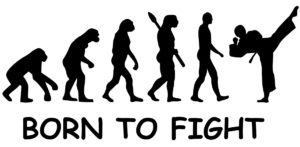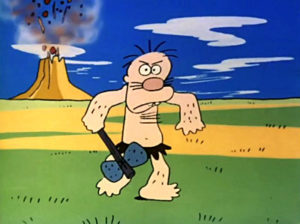ENGLISH

THE KARATE AND THE EVOLUTION OF THE SPECIES
SPECIAL FINAL! I 2 SECRET ENEMIES OF THE COMPETITORS
I know what you are thinking… “this time he’s overdone it a bit, to explain his way of seeing karate did he really need to start from the stone age? Maruko San… you’re exaggerating.”
But no, I am starting from the exact moment when the human mind and body evolved to fight, I am just asking you to show a small amount of RESILIENCE to get to the end of the article.
#Human evolution and persistent hunting
In the PLEISTOCENE age, due to alternating periods of ice and warmth, our ancestors were forced to reinvent themselves and transform themselves from gatherer monkeys to hunters.

Of course, they were hunters out of necessity, to whom no one had granted a hunting permit.
They did not have claws, their molars were flat, their canines were ridiculous and they had a long digestive system like that of a herbivore. Moreover, they were not powerful and fast like a lion or a cheetah.
If you believe, however, that homo sapiens is a weak species, you are truly mistaken.
Human beings have been transformed and shaped by 2 million years of evolution in the savannah, becoming one of the strongest (and mentally resilient) species on the planet.
Don’t you believe it? Okay, let’s continue.
You need to know that there is a type of hunting, still practiced today in some parts of the world, which is called persistent hunting.
It works like this: a group of men run behind their prey, which, after hours of pursuit, falls to the ground due to hypothermia. All that is necessary to kill it is a single blow with a stick if it has not already died of its own accord.
How is all this possible? It is possible because our thermoregulation system is the best in the entire animal kingdom. We can sweat from every part of our body, not just from our mouths like dogs. To change temperature better we have abandoned our fur, aside from a tuft of hair on our heads to protect us from the sun. We are born to run. We are the most resistant animals on the planet.
Consider the fact that since 1983 in Prescott, Arizona, there has been an annual “Man Against Horse Race” across a distance of 80 km. Since 1999, humans have begun to win regularly. Yet the horses are trained for months. The route is mountainous, the climate hot, and the winner finishes the competition in eight hours.

The human mind, like our bodies, has evolved to stay focussed on a single distant aim. The human body is resistant, and the mind resilient – if used correctly – and it is able to confront and adapt itself to every type of difficulty.
We have had to learn to remain concentrated on our prey, listening to the sensations of our body – such as fatigue – while also knowing how to distance ourselves from them, going beyond our limits.
From all this we can learn the two fundamental physical and mental secrets for karate:
#1 Our mind is designed and has evolved to do one thing at a time. Multitasking and karate do not go together.
#2 Our body is naturally resistant. Provided that we are well fed and trained, with the right amount of carbohydrates and the correct body composition (a percentage fat of circa 3% of body mass, i.e. what we would have if we lived in the wild), we have in purity everything that we need to take on a kumite fight or arrive at the end of a kata without effort.
– The great work that a kumite or kata athlete must do on a physical level is not about training their aerobic limits. You will obtain the optimal level of aerobic training for a karate feat almost naturally by simply keeping your weight under control and keeping yourself in shape. The great work for a karate athlete lies in sudden changes in cardiac rhythms and in force/speed. – All these can be “perfected,” but they are not easy to gain by simply keeping yourself in form.
So! This is the direction. Now look for the way!
SPECIAL FINAL!
# THE TWO SECRET ENEMIES OF THE COMPETITOR:
THE COACH STEALS THE STAGE
Who is the coach? What is the use of this person, emotionally tired and sweating, who sits on a seat and goes red in the face when we don’t do what he says?
The coach, you must understand, is not the athlete’s big bald boss, but rather a formidable instrument against your competitors.
The competitor only has to do one thing – remember hashtag number one? – stay concentrated on the enemy. The changes in strategy studied TOGETHER at the table have to be considered and prepared by the coach so that the “only” work left for the athlete is to play the game while maintaining maximum focus on the opponent.
The protagonists are them, the competitors.
When the coach sits on the platform (and not only in a metaphorical sense, sometimes I have seen coachs sneak into athletes’ processions), he steals a place which he does not deserve.
The competition is the celebration, the challenge, the measurement of the athlete. Not that of the coach.
When an athlete’s distorted view results in the sensation of being the “puppet” of the coach, we have to be the first to fight this sensation, it’s easy: TALK ABOUT IT.
We explain to the kids what our function is when we sit at the side on the tatami.
#don’tclimbonthepodium #don’tstealthepodiumforgoodnesssake
DISTRACTION: PUBLIC ENEMY NUMBER ONE.
We are most likely the most distracted and inattentive generation in all of human history.
The reason for this distraction is the fault of our wrong use of technology.
Believe me, I am not a TECHNOPHOBE. I love technology, really!
Unfortunately our mind is not designed to receive the enormous amount of information which we are subjected to every day.
Information which is probably 80% useless. We take a peek at social media every 5 minutes, receive an email every 3.
Our mind is not designed to be used like a sack of rubbish.

The consequence of such massive and ignorant use of information is a brain that functions badly because it is used and trained badly.
Do you think that our performance would be better if we went around all day with a 50 kg bag on our back? Certainly not! Our skeleton would become deformed and our vertebral column and knees would suffer serious consequences.
The same would happen to the brain. We are not made to support thousands of gigabytes of data in the prefrontal cortex.
When the brain is overloaded, our attention span diminishes, the connection with the opponent is reduced and we lose the ability to react immediately to stimuli and to change the way in which we confront the game quickly (attack – defence – return – anticipation).
Our grandmother could beat us up without too much effort.
The solutions?
Technology, use it less, use it better.
Technology needs to become the launch window for our mind into the world, not the other way around.
We have to learn to use it in an aware manner without sinking underneath it all. We need to learn to use information technology to do things first and better, not to frustrate us.
And sometimes, we need to learn to pull out the thorn, to switch off mobile phones, TVs and computers in a purifying way, for a true digital detox, maybe just before a competition.
ALL THIS? Yes, all this.
A little secret, small as a grain of sand, but which seems like a mountain to those who do not know it.
Maruko San.

SPECIAL FINAL! I 2 NEMICI SEGRETI DEI COMPETITOR
Lo so cosa state pensando… “questa volta l’ha presa un po’ alla larga, per spiegarci il suo modo di vedere il karate doveva proprio partire dall’età della pietra! Maruco san… stai esagerando”.
Invece no, sto partendo esattamente dal preciso momento in cui il fisico e la mente umana si sono strutturati ed evoluti per combattere, vi chiedo soltanto un piccolo sforzo di RESILIENZA per arrivare alla fine dell’articolo.
#L’evoluzione umana e la caccia persistente.
Nell’era del PLEISTOCENE, a causa dell’alternarsi di periodi di glaciazione e di calura, i nostri antenati sono stati costretti a reinventarsi e a trasformasi, da scimmie raccoglitrici, a cacciatori.

Ovviamente erano dei cacciatori per necessità, a cui nessuno aveva dato la patente per cacciare.
Non avevano artigli, avevano molari piatti, canini ridicoli e un apparato digerente lungo come quello di un erbivoro. Inoltre, non erano potenti e veloci come un leone o un ghepardo.
Se pensate però, che l’homo sapiens sia una specie debole, vi state sbagliando di grosso.
L’essere umano è stato trasformato e plasmato da 2 milioni di anni di evoluzione nella savana, nella specie più resistente (e mentalmente resiliente) del pianeta.
Non ci credete? Bene , andiamo avanti.
Dovete sapere che esiste un tipo di caccia, praticata ancora oggi in alcune zone della terra, chiamata caccia persistente.
Funziona così: un gruppo di uomini corre dietro una preda, e quella, dopo ore di inseguimento, cade a terra in preda all’ipertermia, tanto che per ucciderla è sufficiente una bastonata, sempre se non sia già morta da sé.
Com’è possibile tutto ciò? E’ possibile perché il nostro sistema di termoregolazione è il miglior sistema di termoregolazione del mondo animale. Possiamo sudare da ogni parte del nostro corpo, non solo dalla bocca come i cani. Per scambiare meglio il calore abbiamo abbandonato la pelliccia, ad eccezione di un ciuffo di peli in testa che serve a proteggersi dal sole. Siamo nati per correre. Siamo gli animali più resistenti del pianeta.
Pensate che dal 1983 a Prescott, in Arizona, si svolge annualmente la “Man Against Horse Race”: una sfida di corsa uomo – cavallo su una distanza di 80 km. Dal 1999, hanno cominciato a vincere regolarmente gli umani. Eppure i cavalli vengono allenati per mesi. Il percorso è montuoso, il clima caldo, e chi vince chiude la competizione intorno alle otto ore.

La mente umana, al pari del nostro fisico, si è evoluta per restare concentrata a lungo su un solo obbiettivo. Il corpo umano è resistente, e la mente resiliente – se utilizzata correttamente – è in grado di affrontare ed adattarsi ad ogni tipo di difficoltà.
Abbiamo dovuto imparare a rimanere concentrati sulla preda, ascoltando le sensazioni del nostro corpo – come la fatica – ma anche a sapercene distaccare, superando i nostri limiti.
Da tutto questo possiamo apprendere due segreti fisici e mentali fondamentali per il karate:
#1 La nostra mente è stata progettata e si è evoluta per fare una cosa alla volta. Il multitasking ed il karate non vanno d’accordo.
#2 Il nostro fisico è naturalmente resistente. Nutrito ed allenato bene, con il giusto apporto di carboidrati e una corretta composizione corporea (una percentuale di grasso di circa il 3% della massa corporea, ovvero quella che avremmo se vivessimo in natura), possediamo in purezza tutta la resistenza necessaria per affrontare un combattimento di kumite o arrivare senza sforzo alla fine di un kata.
– Il lavoro grosso che deve fare un atleta di kumite o di kata, sotto il piano fisico, non è nell’allenamento della soglia aerobica. Otterrete l’allenamento aerobico ottimale per una prestazione di karate quasi naturalmente, semplicemente tenendo il peso sotto controllo e mantenendovi in forma. Il lavoro grosso di un atleta di karate sta nei cambi improvvisi dei ritmi cardiaci e nella forza / velocità. – Tutte cose che sono “perfettibili”, ma che non si conquistano facilmente, semplicemente tenendosi in forma.
Ehi! Questa è la direzione. Adesso cerca la via!
SPECIAL FILNAL!
#I DUE NEMICI SEGRETI DEL COMPETITOR:
IL COACH RUBA PODIO
Chi è il coach? A cosa serve quest’uomo, emozionato sudato e stanco che siede su una seggiolina, e diventa rosso quando non facciamo quello che dice?
Il coach , dovete mettervelo in testa, non è il grande capo calvo dell’atleta, ma è uno strumento formidabile in mano ai competitor.
Il competitor deve fare una cosa sola – ricordate l’hashtag numero uno? – restare concentrato sull’avversario. I cambi di strategia studiati INSIEME a tavolino, devono essere pensati e predisposti dal coach, in modo che all’atleta resti “solo” il compito di fare il suo gioco, mantenendo al massimo la concentrazione sull’avversario.
I protagonisti sono loro, i competitor.
Quando il coach si siede sul podio (a volte anche fisicamente, non solo in senso metaforico. Ho visto Coach intrufolarsi nelle sfilate degli atleti ), ruba un posto che non gli spetta.
La competizione, è la festa, la sfida, la misura, dell’atleta. Non del Coach.
Quando nasce, da una visione distorta dell’atleta, la sensazione di essere “la marionetta” del coach, dobbiamo essere i primi a combattere questa sensazione, è facile: PARLIAMONE.
Spieghiamo ai ragazzi, qual’è la nostra funzione quando ci sediamo a bordo tatami.
#Nonsalitesulpodio #nonrubateilpodiocazzo
LA DISTRAZIONE: NEMICO PUBBLICO NUMERO UNO.
Molto probabilmente, siamo la generazione più distratta e disattenta di tutta la storia dell’umanità.
La colpa di questa disattenzione, risiede nell’utilizzo errato della tecnologia.
Credetemi, chi vi parla non è una persona TECNOFOBICA. Io adoro la tecnologia, davvero!
Purtroppo, la nostra mente, non è stata progettata per ricevere l’enorme quantità di informazioni a cui siamo sottoposti ogni giorno.
Informazioni probabilmente per l’80% inutili. Sbirciamo sui social ogni 5 minuti, riceviamo una mail ogni 3.
La nostra mente non è progettata per essere utilizzata come un sacco della pattumiera.

La conseguenza di un utilizzo così massiccio ed inconsapevole dell’informatica genera un cervello che funzionale male, perché utilizzato ed allenato male.
Secondo voi le nostre prestazioni sarebbero migliori se ce ne andassimo tutto il giorno in giro con uno zaino da 50Kg sulla schiena? Certamente no! Il nostro scheletro si deformerebbe, e la colonna vertebrale e le ginocchia subirebbero conseguenze gravi.
Per il cervello è la stessa cosa. Non siamo fatti per sopportare giga e giga di dati scaricati nella corteccia prefrontale.
Quando il cervello è sovraccarico, l’attenzione diminuisce, la connessione con l’avversario è affievolita, e perdiamo la capacità di reagire immediatamente agli stimoli e di cambiare velocemente la modalità in cui affrontiamo la situazione di gioco (attacco – difesa – rimessa – anticipo).
Nostra nonna potrebbe picchiarci senza troppi sforzi.
Le soluzioni?
La tecnologia, utilizzarla meno, utilizzarla meglio.
La tecnologia deve diventare la finestra di lancio della nostra mente sul mondo, non il contrario.
Dobbiamo imparare ad utilizzare i mezzi in maniera consapevole e non subirli e basta. Dobbiamo imparare ad utilizzare l’informatica per fare prima e fare meglio, non per frustrarci.
E a volte, dobbiamo imparare a staccare la spina, a spegnere, in maniera depurativa, cellulari tv e computer, in quello che potrebbe diventare un vero e proprio digiuno informatico, magari proprio a ridosso di una competizione.
TUTTO QUA? Si tutto qua.
Un segreto piccolo come un granello di sabbia è una montagna per chi non lo conosce.
Maruko San.
0 commenti